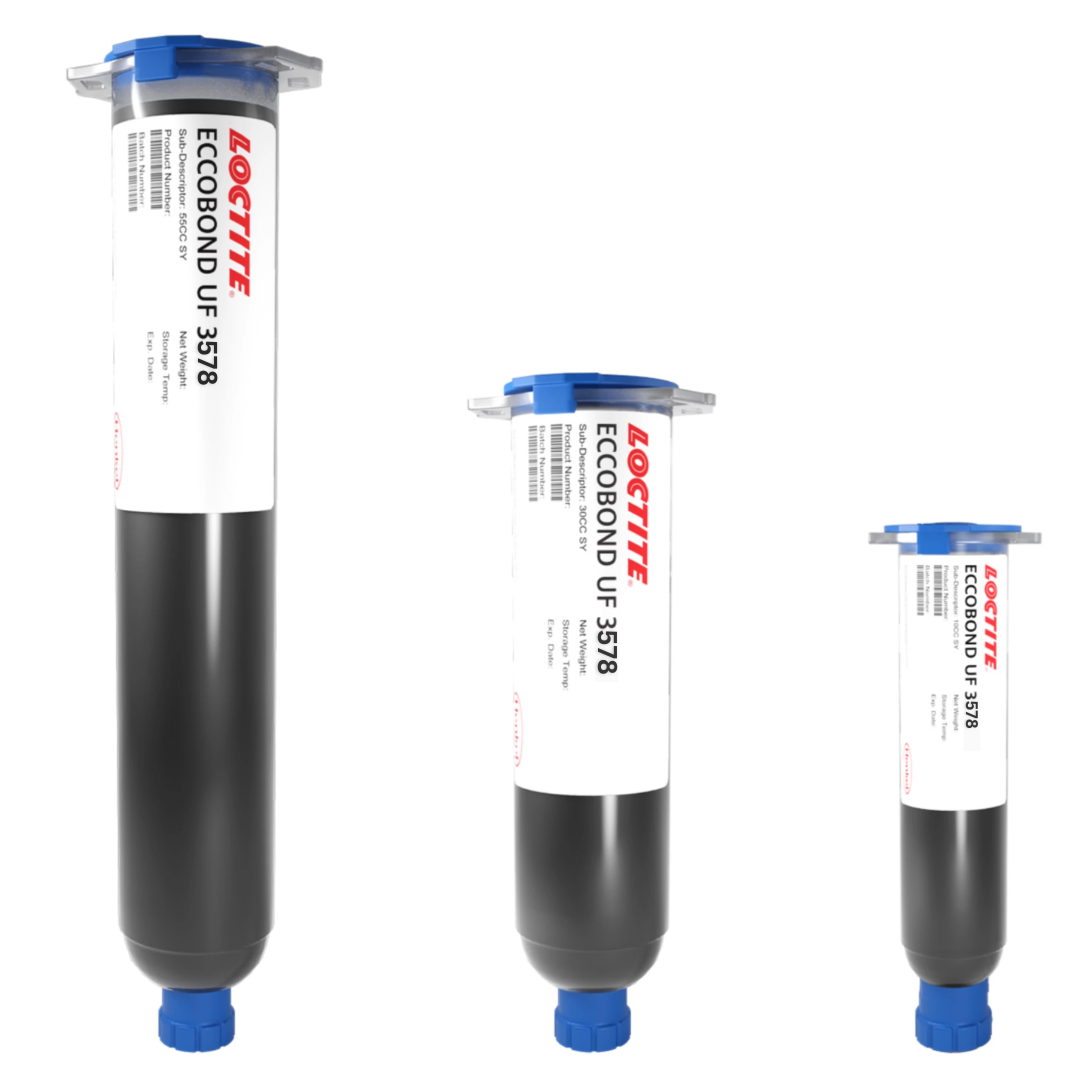LOCTITE ECCOBOND UF 3578
- Fast heat-cure adhesive designed for underfill and fixture applications
- Thixotropic and fluorescent for controlled flow and optical inspection
- Reflow-compatible for SMT processes
Product Description
LOCTITE® ECCOBOND UF 3578 is a one-component, heat-curable epoxy underfill designed to provide mechanical reinforcement and encapsulation in surface mount PCB assemblies. Its thixotropic, fluorescent formulation makes it especially well-suited for applications involving capacitors, resistors, connectors, and WLCSPs, where precise flow control and post-process inspection are critical.
This adhesive offers fast curing at 120 °C in just 10 minutes and is fully compatible with solder reflow processes, eliminating the need for separate curing stages. LOCTITE® ECCOBOND UF 3578 ensures excellent mechanical strength and thermal protection while maintaining ease of use.
Applications
- Underfill for WLCSP, capacitors, resistors, and connectors
- Reinforcement and protection in SMT and PCB assembly
- Electronics requiring fast cure and reflow-process compatibility
- Optical inspection environments (fluorescent visibility)
Technical Specifications
| General Properties | |||||||
| Color Color The color | Black | ||||||
| Density (g) | 1.4 g/cm3 | ||||||
| |||||||
| Physical Properties | |||||||
| Thixotropic index Thixotropic index Thixotropic Index is a ratio of a material s viscosity at two different speeds in Ambient temperature, generally different by a factor of ten. A thixotropic material s viscosity will decrease as agitation or pressure is increased. It indicates the capability of a material to hold its shape. Mayonnaise is a great example of this. It holds its shape very well, but when a shear stress is applied, the material easily spreads. It helps in choosing a material in accordance to the application, dispense method and viscosity of a material. | 3.9 | ||||||
| Viscosity Viscosity Viscosity is a measurement of a fluid’s resistance to flow. Viscosity is commonly measured in centiPoise (cP). One cP is defined as the viscosity of water and all other viscosities are derived from this base. MPa is another common unit with a 1:1 conversion to cP. A product like honey would have a much higher viscosity -around 10,000 cPs- compared to water. As a result, honey would flow much slower out of a tipped glass than water would. The viscosity of a material can be decreased with an increase in temperature in order to better suit an application | 55,000 mPa.s | ||||||
| Thermal Properties | |||||||
| |||||||
| Glass Transition Temperature (Tg) Glass Transition Temperature (Tg) The glass transition temperature for organic adhesives is a temperature region where the polymers change from glassy and brittle to soft and rubbery. Increasing the temperature further continues the softening process as the viscosity drops too. Temperatures between the glass transition temperature and below the decomposition point of the adhesive are the best region for bonding. The glass-transition temperature Tg of a material characterizes the range of temperatures over which this glass transition occurs. | 121 °C | ||||||
Additional Information
Cure Profile
- 10 minutes at 120 °C (standard cure)
*Compatible with standard solder reflow processes
Thawing Instructions
- Allow container to reach room temperature before use.
- After removing from the freezer, set the syringes to standvertically while thawing.
- Thaw time typically 1 hour for 30/55cc syringe .
- Consult handling guide for more information.
- DO NOT open the container before contents reach 25 °Ctemperature. Any moisture that collects on the thawed containershould be removed prior to opening the container.
- DO NOT re-freeze. Once thawed to 25 °C, the adhesive shouldnot be re-frozen.
Storage & Handling
Store between 2–8 °C in original packaging
Work life and dispensing stability require proper thaw and dispense procedures




